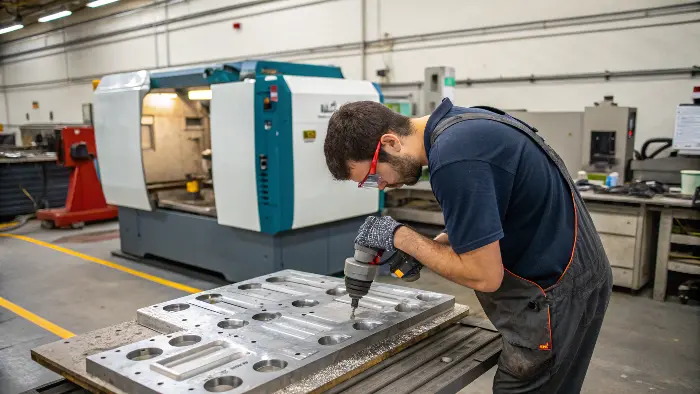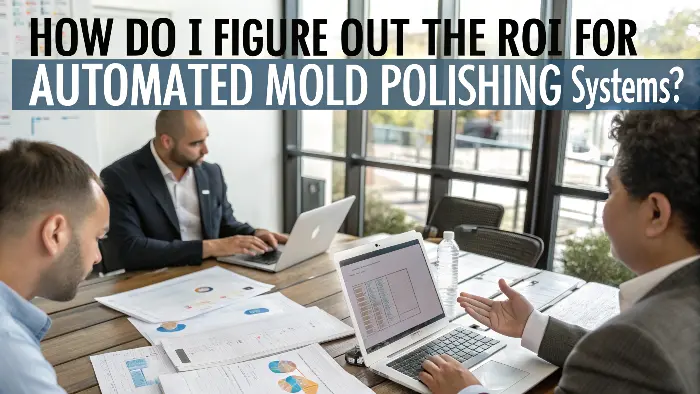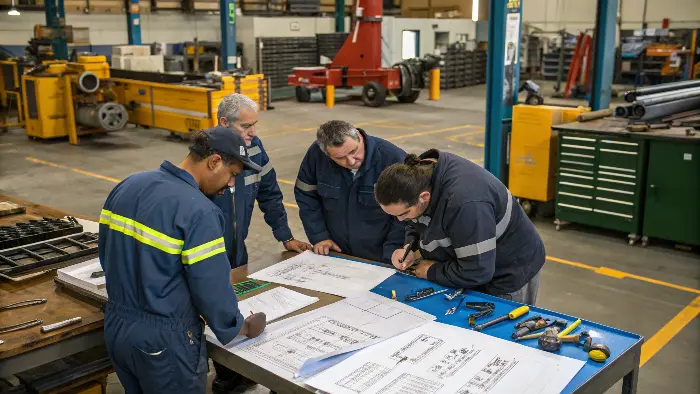Tired of battling inconsistent mold finishes and those never-ending polishing hours? Manual polishing, let’s be honest, can be a real drag—slow, costly, and so dependent on individual skill. But what if there’s a smarter way?
Automated polishing for injection molds uses robotic or CNC systems to achieve consistent, high-quality surface finishes. This seriously cuts down on manual labor, speeds up your turnaround times, and ultimately boosts your overall efficiency. It’s a game-changer, really.
So, you’re probably thinking about automated polishing now, but maybe you’re wondering if it’s truly worth the investment and how on earth you’d even start. I get it; new tech can seem a bit much at first. But stick with me. We’re going to break this down, piece by piece, so you can see what this technology really means for your mold-making business and how it can help you master molding right. Let’s dive in and see if this is the leap your shop needs.
What Exactly is This "Automated Polishing" Buzz All About Anyway?
That term "automated polishing" gets thrown around a lot, and it can sound pretty complex, maybe even a bit intimidating. You might be picturing massive, complicated robots taking over, wondering if it’s even practical for your setup. But really, it’s about using smart technology to get better, more consistent finishes without all the manual grind.
Essentially, automated mold polishing employs technologies like agile robotic arms or precise CNC machines. These are kitted out with specialized tools to systematically remove material and smooth out mold surfaces, achieving incredibly precise finishes without needing someone hovering over them constantly.
Let’s dig a little deeper into what makes these systems tick. It’s not just one-size-fits-all, you know. There are a few flavors of this tech.
Robotic Polishing Systems
When I first saw a robotic arm polishing a mold, I was fascinated. These systems typically use multi-axis robots – think those flexible arms you see in car plants, but adapted for delicate work. They can reach complex geometries that would give a manual polisher a headache. They follow a programmed path, applying consistent pressure with various abrasive tools. The beauty here is their adaptability; you can program them for different mold shapes and sizes. It’s a far cry from the old days, I tell you. We once had a really intricate mold, took us ages manually, and even then, consistency was a prayer. A robot would have nailed it.
CNC-Based Polishing
Then you’ve got CNC-based polishing. This is more like your typical CNC milling machine, but instead of cutting tools, it’s equipped with polishing heads. These are fantastic for flatter or less complex curved surfaces where precision pathing is key. They offer incredible accuracy and repeatability. Imagine setting up the program and letting the machine work its magic, hitting those tight tolerances every single time. It’s pretty satisfying.
Key Technologies Involved
Underpinning all this are some clever technologies. We’re talking sophisticated software for path generation – often derived from the mold’s CAD model. Force sensors are also a big deal, allowing the system to adjust pressure in real-time, which is crucial for achieving specific surface finishes without over-polishing. And, of course, the polishing media itself: specialized abrasive stones, diamond pastes, lapping films, and brushes, all selected for the material of the mold and the desired SPI finish. It’s a blend of mechanical precision and smart control.
So, Why Should I Ditch My Tried-and-True Manual Polishing Methods?
Sticking with what you know – good old manual polishing – feels safe, doesn’t it? I’ve been there. But are you truly "working," or are you just working harder, constantly fighting bottlenecks, operator fatigue, and those frustrating inconsistencies that end up costing you more than you think? Automation isn’t just a fancy upgrade; it offers some seriously compelling advantages.
Switching to automated polishing significantly boosts consistency in your finishes, reduces that heavy reliance on highly skilled (and often hard-to-find) labor, drastically cuts down polishing time, and ultimately leads to higher quality molds and better parts for your customers.

I remember back when we relied solely on manual polishing for a high-volume job. The stress levels were through the roof trying to match finishes across shifts! If we’d had automation then… well, let’s just say I’d have slept a lot better. Thinking about making the switch? Here’s why it’s more than just a good idea:
Unbeatable Consistency and Quality
This is a big one. Humans, even the most skilled, have good days and bad days. Automated systems don’t. They deliver the same path, the same pressure, the same motion, every single time. This means you can achieve incredibly consistent SPI finishes (like A1 or A2) across the entire mold surface and from one mold to the next. For our customers, especially someone like Alex who’s managing projects for consumer electronics, that level of predictable quality is gold. It means fewer rejected parts, less rework, and happier clients. We once had a client who was extremely picky about optical clarity – automated polishing would have saved us so many headaches and debates.
Tackling the Skilled Labor Shortage
Let’s be frank: finding and retaining highly skilled manual polishers is tough, and it’s not getting any easier. These are true artisans, but they are becoming a rare breed. Automation doesn’t necessarily replace your skilled team; it elevates them. It takes over the repetitive, physically demanding tasks, freeing up your experienced polishers to focus on more complex challenges, programming, or quality control. It also makes the job more appealing to a younger workforce that’s more tech-inclined. Think of it as giving your best players better tools so they can win more games.
Speeding Up Your Workflow
Manual polishing is often the biggest bottleneck in mold making. It’s time-consuming, and you can only throw so many people at it. Automated systems can work faster, often around the clock if needed, with minimal supervision. This dramatically reduces the time it takes to get a mold from machining to the press. Shorter lead times mean you can take on more jobs, respond quicker to customer demands, and ultimately, increase your shop’s throughput and profitability. I recall a rush job where the polishing phase nearly broke us; an automated cell could have turned that panic into a smooth operation. Plus, a safer workshop with less dust and repetitive strain injuries is a huge bonus too.
The Big Question: How Do I Figure Out the ROI for Automated Mold Polishing Systems?
Alright, the benefits sound great, but new technology always comes with a price tag. And the first thing your boss, or even the practical side of your own brain, is going to ask is, "What’s the payback on this thing?" You might be a bit hesitant, worried about that big upfront investment without a crystal-clear picture of the return. It’s a valid concern! I’ve been in those budget meetings.
To calculate the ROI for automated polishing, you need to carefully compare the total investment (machine, installation, software, training) against the tangible savings you’ll get from reduced labor, faster cycle times, fewer reworks, and increased capacity over a specific period.

It’s not just about the sticker price of the machine; it’s about what that machine does for your bottom line. Let’s break down how you can build a solid case for this investment. It’s not as scary as it sounds, I promise.
Tallying Up the Investment Costs
First things first, you need to list out all the upfront costs. This isn’t just the polishing machine itself. Think about:
- The System: The robotic cell or CNC polishing machine.
- Software: CAM software for path programming, simulation tools.
- Tooling: A starter set of polishing heads, abrasives, and any specialized fixtures.
- Installation & Commissioning: Getting it set up and running correctly.
- Training: This is crucial! Budget for training your operators, programmers, and maintenance staff. Don’t skimp here; it’s an investment in itself.
- Facility Upgrades: Do you need better power, compressed air, or a dedicated space?
I always advise people to get detailed quotes and add a small contingency – projects always have little surprises.Identifying Your Key Savings Areas
Now for the good part – where will you save money or make more?
- Reduced Labor Costs: This is often the biggest one. Calculate the hours saved on manual polishing. Think direct wages, overtime, benefits. Even if you reassign staff, their time is now more valuable.
- Increased Throughput: If you can polish molds faster, you can make more molds. How many more molds per month or year? What’s the profit on those?
- Reduced Rework & Scrap: Consistency from automation means fewer mistakes, less time spent fixing them, and less material waste. This was a huge win for us on a particularly tricky series of molds. The scrap rate plummeted after we automated a similar finishing process.
- Material Savings: More precise polishing can mean less aggressive material removal, saving on expensive tool steel over time or using less polishing consumables.
- Attracting New Business: Being able to offer higher, more consistent finishes or faster turnaround can open doors to new customers or higher-margin work.
A Simple ROI Calculation Framework
Once you have your costs and your projected savings (usually per year), you can use a simple ROI formula:
ROI (%) = [(Net Profit from Investment – Cost of Investment) / Cost of Investment] x 100
Or, for a payback period:
Payback Period (Years) = Cost of Investment / Annual Savings
For example, if a system costs $150,000 all-in, and you project annual savings of $75,000 (from labor, rework, increased output), your payback period is 2 years. After that, it’s pure profit. I always suggest running a few scenarios – conservative, realistic, and optimistic – to see the range. It really helps to put things in perspective.Alright, I’m In! What Are the Key Steps to Actually Implement Automated Polishing in My Shop?
Okay, so you’ve seen the benefits, crunched some numbers, and you’re thinking, "This automated polishing thing? It actually makes sense!" That’s great! But then comes the next big thought: "Where do I even start with bringing this into my workshop?" The idea of disrupting your current flow and getting everyone up to speed can feel a bit daunting. I’ve guided a few shops through this, and trust me, a structured approach makes all the difference.
Implementing automated polishing successfully involves a clear process: thoroughly assessing your specific needs, carefully selecting the right system, preparing your facility, investing in comprehensive team training, and then starting with pilot projects before going all-in. It’s a journey, not a sprint!

Don’t try to boil the ocean. Taking it step-by-step will make the transition smoother and set you up for long-term success. Let’s walk through what that looks like.Step 1: Figuring Out What You Really Need
Before you even look at brochures, take a hard look at your own operations. What kinds of molds are you polishing most often? What are the typical sizes, complexities, and materials? What SPI finishes are you usually aiming for? Where are your current polishing bottlenecks? Are there specific types of defects you’re constantly battling? I once saw a shop buy a super-complex robotic system when a simpler CNC polisher would have done 90% of their work for half the cost. So, document your requirements clearly. This will be your shopping list.
Step 2: Choosing Your Automated Polishing Partner
Now you can start looking at vendors. Don’t just go for the cheapest or the flashiest. Look for a partner, not just a supplier. Consider:
- System Capabilities: Does their equipment match your needs from Step 1?
- Software & Integration: How easy is it to program? Does it integrate with your existing CAD/CAM systems?
- Support & Service: What kind of training do they offer? What’s their technical support like? Are spare parts readily available? This is where a company like us, CAVITYMOLD, always emphasizes partnership.
- References & Demos: Ask for case studies. Better yet, see the system in action, ideally polishing a part similar to yours.
Step 3: Getting Your Shop Ready
Once you’ve chosen a system, you’ll need to prepare your shop floor. This might involve:
- Space Allocation: These systems need a dedicated footprint.
- Utilities: Ensure you have adequate power, compressed air, and possibly data connections.
- Foundation: Some larger systems might have specific floor loading requirements.
- Workflow Planning: How will molds flow to and from the automated cell?
Thinking about this early prevents headaches during installation.Step 4: Don’t Skimp on Training!
I cannot stress this enough – training is paramount. Your team needs to be comfortable and proficient. This includes:
- Operators: How to run the machine, load/unload parts, perform basic troubleshooting.
- Programmers: How to create and optimize polishing paths using the CAM software. This is a real skill.
- Maintenance: How to perform routine maintenance and diagnose issues.
Invest in good quality training, even if it means sending people off-site. It’ll pay off massively in uptime and efficiency. We always found that hands-on training with our actual parts was the most effective.Step 5: Start Smart, Not Big
Don’t try to automate everything on day one. Begin with pilot projects. Choose a few representative molds and work through the entire process – programming, setup, polishing, inspection. This allows your team to learn in a less pressured environment. You’ll identify challenges, refine your processes, and build confidence. It’s like learning to ride a bike; you start with training wheels.
Step 6: Keep Getting Better
Implementation isn’t a one-time event. It’s the start of a continuous improvement journey. Regularly review your automated polishing performance. Are you hitting your targets for cycle time and quality? Are there new techniques or tooling you could try? Solicit feedback from your team. Technology evolves, and so should your processes. Keep learning, keep tweaking, and keep pushing for better results.
Conclusion
Automated mold polishing isn’t just some far-off dream; it’s a practical, strategic move for better quality, faster turnarounds, and a healthier ROI. Ready to explore how CAVITYMOLD can help you Master Molding Right?
